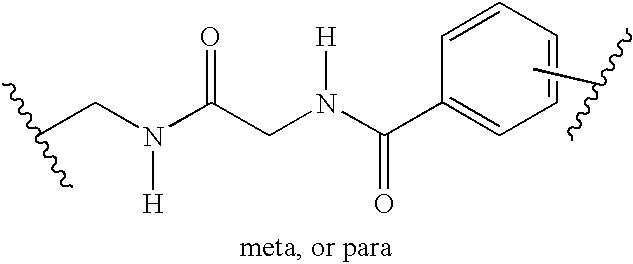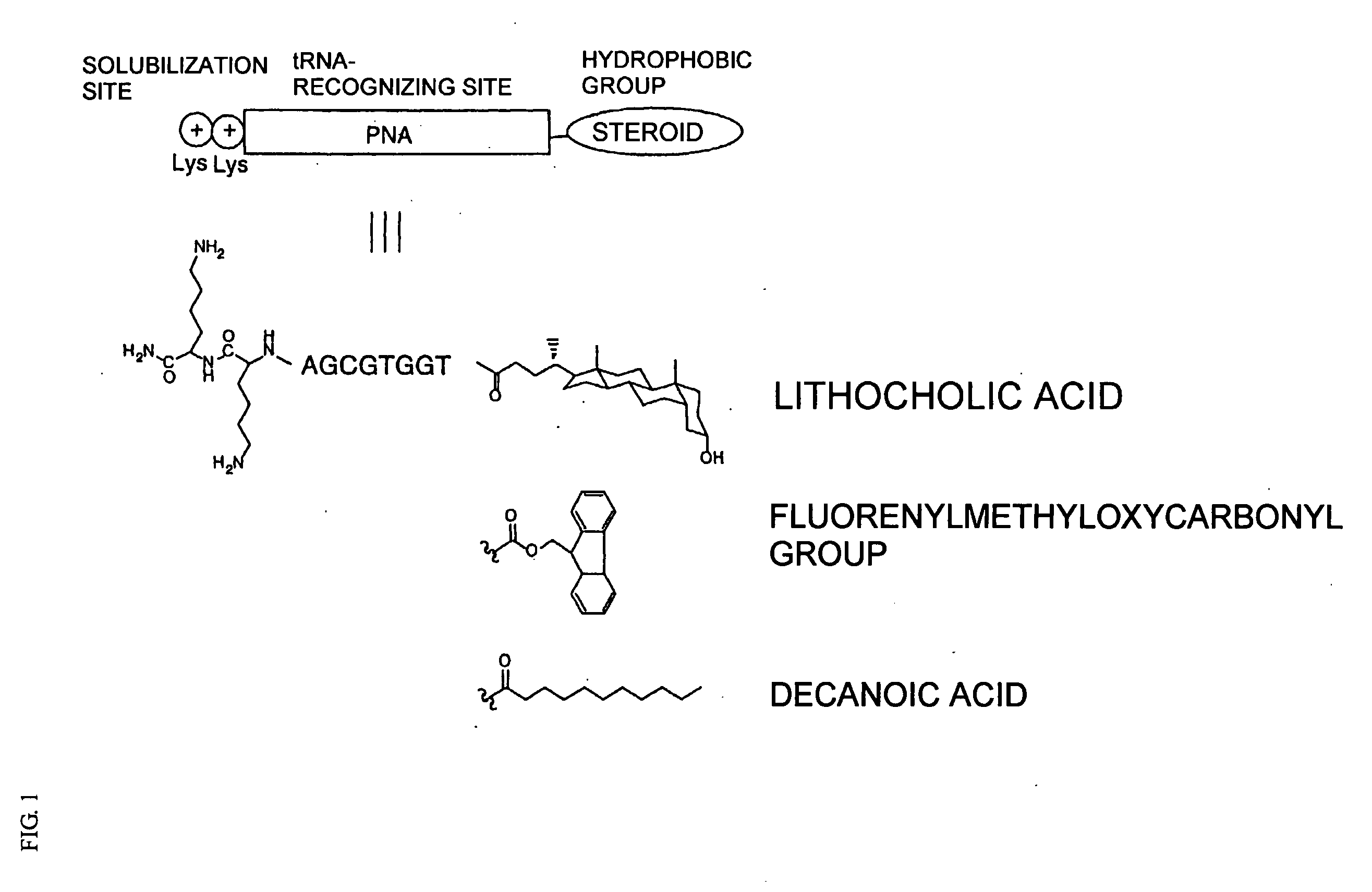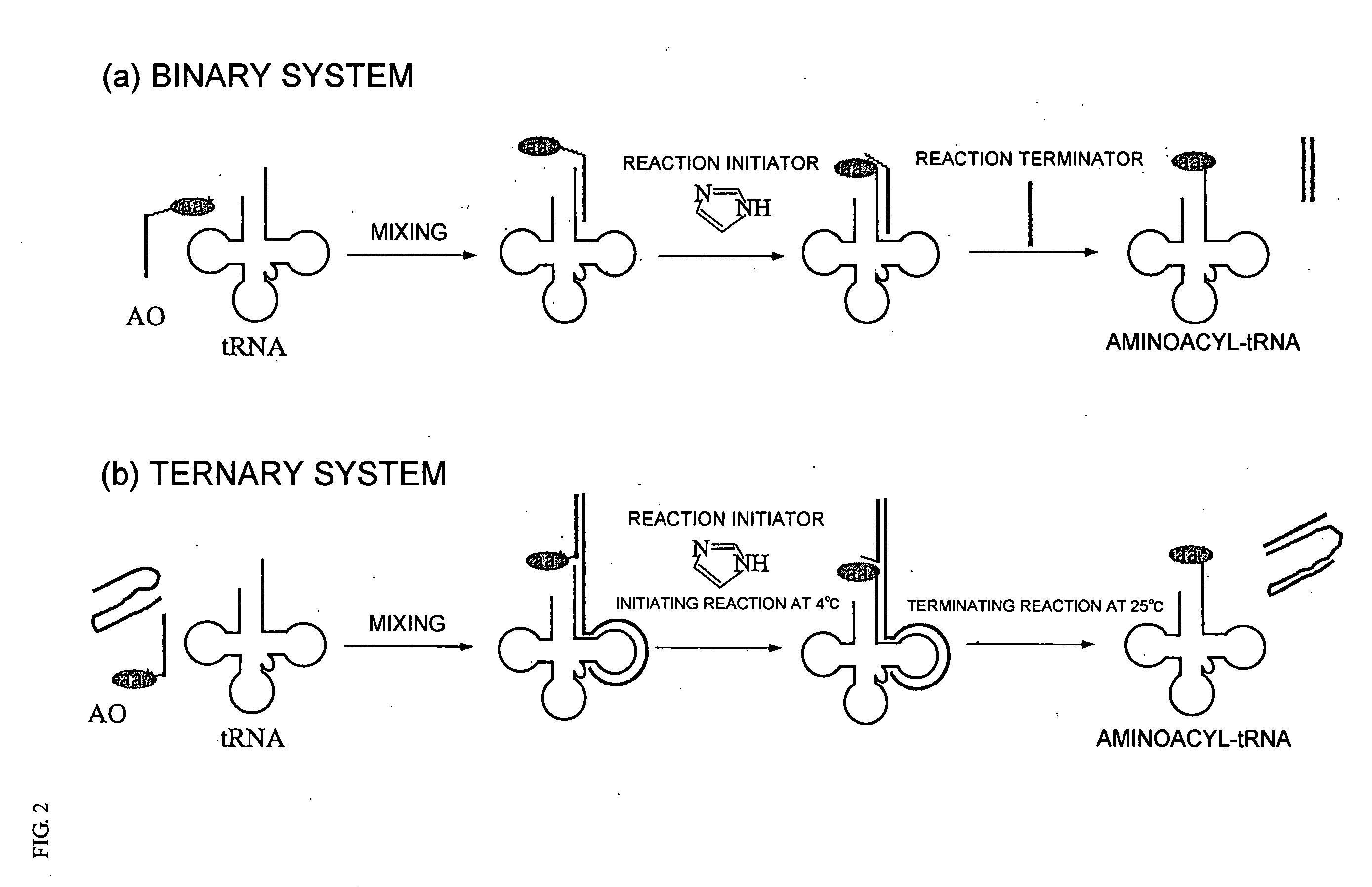Method of aminoacylating trna
a technology of aminoacylated trna and aminoacylated trna, which is applied in the direction of peptide/protein ingredients, immunoglobulins, peptides, etc., can solve the problems of difficult to understand the functions of a number of proteins, limited methods, and complicated methods, and achieve efficient and highly practical effects
- Summary
- Abstract
- Description
- Claims
- Application Information
AI Technical Summary
Benefits of technology
Problems solved by technology
Method used
Image
Examples
examples
[0150] Hereunder, the present invention will be explained in more detail with reference to the Examples, however, the present invention is by no means limited to these Examples. Example 1 (Aminoacylation of tRNA using non-ionic micelle)
[0151] Using 2-naphthyl alanine having a naphthyl group at the side chain which has been subjected to an active esterification as a nonnatural amino acid, aminoacylation was carried out by reacting this 2-naphthyl alanine with a tRNA in the presence of a peptide nucleic acid (PNA). Incidentally, as the PNA, CGTGGT with a chain length n of 6, in which an Fmoc group and a LysLys group had been introduced as a hydrophobic group and a solubilization site, respectively, was used.
0.5 M Tween #205μL (final concentration = 250 mM)Nvoc-napAla-OCM1μL (final concentration = 100 mM)(1 M / toluene) 4 M imidazole-AcOH, pH 6.51μL (final concentration = 400 mM)0.4 mM tRNA2μL (final concentration = 80 μM)0.8 mM Fmoc-PNA1μL (final concentration = 80 μM)10μL
[Operatio...
example 2
(Aminoacylation of tRNA Using Non-Ionic Micelle)
[0157] A reaction and a post-treatment were carried out in exactly the same manner as in Example 1 except for changing the composition of the reaction solution for aminoacylation as described below. The obtained product was analyzed in the same manner as in Example 1, whereby a similar result to that of Example 1 was obtained. The yield was 13%.
0.5 M Tween #405μL (final concentration = 250 mM)Nvoc-napAla-OCM1μL (final concentration = 100 mM)(1 M / toluene) 4 M imidazole-AcOH, pH 6.51μL (final concentration = 400 mM)0.4 mM tRNA2μL (final concentration = 80 μM)0.8 mM Fmoc-PNA1μL (final concentration = 80 μM)10μL
example 3
(Aminoacylation of tRNA Using Cationic Micelle)
[0158]
20 mM CTACl / 100 mM imidazole (pH 7.5)18μL100 mM Pentenoyl-napAla-OCM / DMF1μL200 μM tRNA1μL20μL
[0159] The foregoing reaction solution was mixed for 10 minutes using a vortex mixer. In addition, the solution on the sidewall was brought down by centrifugation with a bench centrifuge every time when mixing is carried out for 20 to 40 seconds. To the reaction solution, 60 μL of 1.5 M AcOK was added, and 80 μL of phenol / chloroform (1:1) was further added and the mixture was mixed with a vortex mixer for several seconds (it turned out to be a white suspension). Then, the mixture was centrifuged at 15,000 rpm for several seconds at 4° C. and the supernatant was recovered. To the recovered supernatant, 80 μL of CHCl3 / i-PrOH (24:1) was added and the mixture was mixed with a vortex mixer for several seconds (it turned out to be a white suspension). In the same manner as above, the mixture was centrifuged at 15,000 rpm for several seconds at...
PUM
| Property | Measurement | Unit |
|---|---|---|
| Volume | aaaaa | aaaaa |
| Volume | aaaaa | aaaaa |
| Volume | aaaaa | aaaaa |
Abstract
Description
Claims
Application Information
 Login to View More
Login to View More - R&D
- Intellectual Property
- Life Sciences
- Materials
- Tech Scout
- Unparalleled Data Quality
- Higher Quality Content
- 60% Fewer Hallucinations
Browse by: Latest US Patents, China's latest patents, Technical Efficacy Thesaurus, Application Domain, Technology Topic, Popular Technical Reports.
© 2025 PatSnap. All rights reserved.Legal|Privacy policy|Modern Slavery Act Transparency Statement|Sitemap|About US| Contact US: help@patsnap.com



